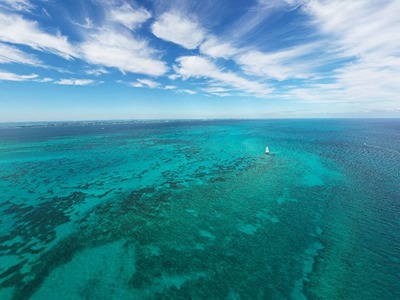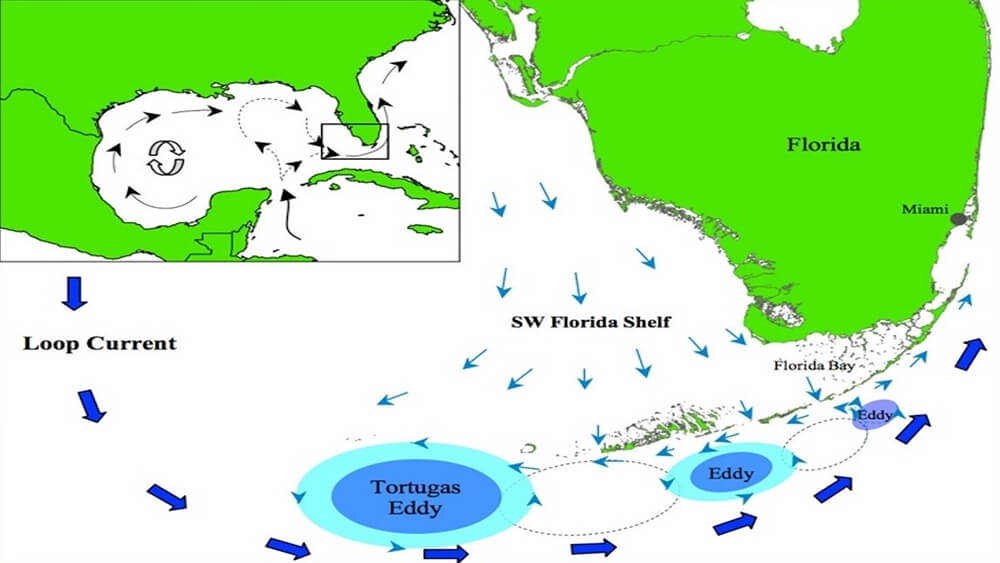Physical Oceanography

Conservation Issue
Oceanographic processes affect the spatial distribution of coral reefs and associated habitats; the distribution of nutrients and pollutants; patterns of larval dispersal, transport and settlement; and health, gene flow, and genetic diversity within these habitats. Within the Florida Keys, circulation patterns and exchange processes controlling water masses fluctuate at varying spatial and temporal scales, confounding our understanding of oceanographic connectivity and influence of water movement on biological processes.
Description
Regionally, the Florida Keys are hydrologically linked with the Everglades and Florida Bay, the Gulf of Mexico, Atlantic Ocean, and South Florida. Although components of regional circulation are understood, there is a need for a comprehensive study of the long- and short-term variations in circulation, ultimately leading to the development of a Florida Keys circulation model that illustrates flow features down to the scale of individual reefs and reef passages, and can resolve complex topographical features such as inlets, channels, and small islands. The complex topography and geology of the Florida Keys, combined with the seasonally variable interactions between multiple water masses in the region, make for highly variable flow patterns that are difficult to predict. Timing, strength, and direction of flow patterns are critical to water quality and distribution and dispersal of marine life from areas within the Florida Keys. Improved understanding of circulation patterns requires continued and enhanced physical oceanographic monitoring and modeling, and greater use of remote sensing.
Data and Analysis Needs
- Reestablished SEAKEYS network of C-MAN monitoring buoys or other similar buoys to provide a long-term meteorological and oceanographic data set
- Integration of existing water circulation monitoring projects with remote sensing, which may provide a cost-effective way of tracking circulation patterns and validating model predictions
- Effects of changing ocean conditions on local circulation patterns and water properties
- Influence of local and regional water circulation on water quality in the Florida Keys
- Evaluation of how physical oceanographic processes can be used to gain insight into biological processes, such as coral bleaching, larval transport, fish spawning and recruitment events, marine debris transport, etc.
Potential Products
- Larval recruitment, dispersal, and connectivity models that include sources, sinks, concentrations, and behavior of larvae, and characterize the influence of local and regional currents and eddies on the recruitment, growth, and survival of key corals, fishes, motile invertebrates, and other indicator species
- Biophysical models that incorporate fine-scale patterns of ocean circulation and the life history traits of coral larvae transported by these currents to estimate connectivity in large reef systems and identify optimal sites for restoration
- Circulation model for FKNMS that will interface with other models and tie together local, regional, and larger-scale patterns necessary to understand and predict larval transport, advection of nutrients, and distribution and transport of pollutants and disease pathogens
- Maps and models of source and sink reefs to better understand larval transport within FKNMS, identify optimal locations for restoration, and potential locations most susceptible to pollution and pathogens
- Real-time data on weather, currents and waves, temperature and salinity, and other oceanographic parameters

For more information about this assessment, contact Andy.Bruckner@noaa.gov.

